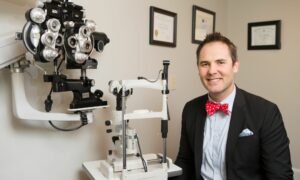
Dec. 16, 2015
Many of your patients see room for improvement in their toric contact lens-wearing experience, according to a recent study by SynergEyes, a provider of hybrid contact lens technology and contact lenses. Eighty-two percent of toric wearers reveal that they frequently experience issues with their toric lenses. Of those, almost 40 percent experience issues three, or more, times per day. The issues include blurry and hazy vision, fluctuating, unstable and shifting vision, rotating lenses and discomfort.
According to a recent study by SynergEyes “Eighty-two percent of toric wearers reveal that they frequently experience issues with their toric lenses.” That’s significant. That needs attention now, not later!
Specialty contact lenses go beyond simple spherical soft lenses and include scleral contact lenses, hybrid contact lenses, rigid gas permeable contact lenses and custom soft lenses. Fitting these types of lenses not only solves patient problems; it also gives your practice a niche that sets you apart from other practices.
Here are the 7 steps that will get you up and running with specialty contact lenses.
Get educated
The first step in this process is to get educated on the type or types of specialty contact lenses you want to fit. Most contact lens manufacturers have excellent training programs. There are contact lens programs that are offered both in-office and online. In addition, here are two web sites that contain excellent information: The Gas Permeable Lens Institute and the Scleral Lens Education Society (SLS).
A key point in getting educated is to follow the manufacturer’s fitting guide. Just in case you are ignoring that point because you think that your experience is better than the manufacturer’s research – follow the manufacturer’s fitting guide for better fits and reduced remakes.
Get the necessary equipment
You need to make sure that you have the necessary instrumentation beyond what is needed for a comprehensive eye examination. You need equipment for:
• Tear quality and quantity
• Corneal topography (axial map, elevation map, tangential map)
• Horizontal Visible Iris Diameter
• Clearance or touch under the contact lens (e.g.: OCT)
• Photos and video
Don’t overlook the power of diagnostic lens fitting sets
Diagnostic lens fitting sets are really helpful. These sets reduce both chair time and remakes. Some estimates are that remakes are reduced by 50 percent when using a diagnostic lens fitting set. That’s significant from both the patient’s perspective and the doctor’s perspective.
Utilize contact lens consultants
Most contact lens companies have contact lens consultants. These consultants can help with everything from the initial fit to helping problem-solve fitting challenges that turn up in your chair. The odds are high that your problem is not the first time these consultants have seen the issue.
Give the consultant as much information as possible. In-depth histories describing what has and has not worked for the patient, as well as what lenses you have tried with the patient and the results, help the consultant. Give the consultant information about tear quality and quantity; corneal topography (axial map, elevation map, tangential map); Horizontal Visible Iris Diameter; clearance or touch under the contact lens; as well as photos and video of the contact lens on the eye with and without fluorescein. All of this helps the consultant help you.
Clear documentation
Documentation is not only necessary so that you can look back on your notes and know what happened with the patient; your documentation also must communicate clearly to staff so that the correct contact lens is ordered for the patient. Create the forms necessary to make documentation in the exam room as easy as possible. With radio buttons and pull-down menus, you can make this documentation clearer and easier.
Staff training
The reason we hire staff is to help us care for our patients. To deliver excellent care means we need to train our staff to help us. Make a list of exactly what you want each staff member to do in helping you care for patients who need specialty contact lenses. As an example, if you want a chair-side assistant to scribe for you, then make sure they are trained to scribe for specialty contact lenses. The better you train your staff, the better care you will deliver to your patients.
Systems
Think of the entire process for handling patients needing specialty contact lenses from start to finish. A good way to do this is to use Post-it Notes to write down each step. (The reason for Post-it Notes is so that you can move things around in case you forgot something or want to add something). You are creating what is called a Process Map. Make sure you have the entire process the way you want it to be, then you have your system you want to implement in your practice. Once you have your system in place in your office and debugged, then review it every six months to make sure it is running effectively and efficiently.
Take this week to focus on the specialty contact lens portion of your practice. Let the 82 percent of toric contact lens wearers with problems happen in other practices. Instead, let your practice be known as the practice that keeps people from having contact lens problems, and solves them when they do happen.
Click HERE for a helpful article if you want to read more about specialty contact lenses.



























